Virtual Science Museum
Miscellaneous Items
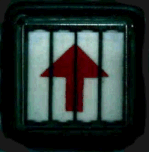 This is a totally bizarre electromechanical indicator device made by
Dowty. It uses four triangular sections which are rotated by a rack
arrangement. The indicator normally displays the red up arrow, but
when either of two electromagnets are energized, the triangles rotate
to display one of the other two legends.
This is a totally bizarre electromechanical indicator device made by
Dowty. It uses four triangular sections which are rotated by a rack
arrangement. The indicator normally displays the red up arrow, but
when either of two electromagnets are energized, the triangles rotate
to display one of the other two legends.
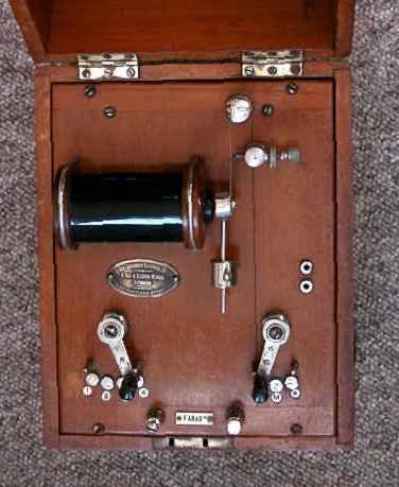 This hand crafted box is labelled 'The Cox-Cavendish Electrical Co.
Ltd. X-Ray & Electro-Medical Apparatus'. It appears to contain an
induction coil. I tried connecting it to a dc supply and it started
making a threatening noise rather like a rattle snake. It is almost
certainly a faradic medical battery, used for muscular therapy.
This hand crafted box is labelled 'The Cox-Cavendish Electrical Co.
Ltd. X-Ray & Electro-Medical Apparatus'. It appears to contain an
induction coil. I tried connecting it to a dc supply and it started
making a threatening noise rather like a rattle snake. It is almost
certainly a faradic medical battery, used for muscular therapy.
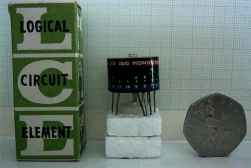 This is an early digital component which they called a logical
circuit element. This device is a monostable.
This is an early digital component which they called a logical
circuit element. This device is a monostable.
50 pence piece for scale.
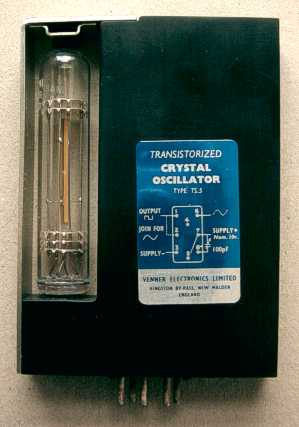 This is a 100kHz crystal oscillator module. The crystal is in the
glass tube. It was made by Venner Electronics Limited and contains germanium
transistors. The module is potted in solid plastic. It measures 125mm
high including the pins.
This is a 100kHz crystal oscillator module. The crystal is in the
glass tube. It was made by Venner Electronics Limited and contains germanium
transistors. The module is potted in solid plastic. It measures 125mm
high including the pins.
Place your pointer over the picture to see an X-Ray of the module.
Dark areas are low density and light areas are high density.The rectangle, top
center, appears to be a mica capacitor. The large white discs are probably ferrite
cored inductors or transformers. The three small white tubes on the right are
germanium transistors.
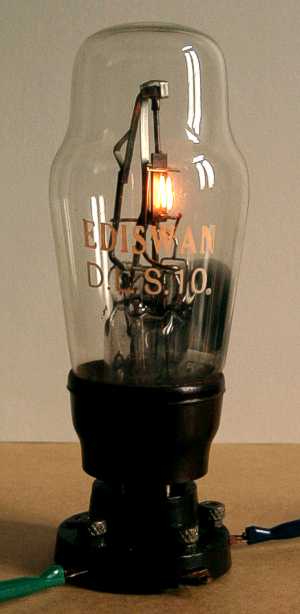 Ediswan DLS10 time delay switch.
Ediswan DLS10 time delay switch.
A 4V filament on the right heats a bi-metallic strip. After a delay
of about one minute, the bi-metallic strip bends sufficiently to close
the contacts at the top of the device. It is evacuated and contains
a getter.
The switch has a standard BVA 4 pin valve base. It was used in a Hirst welding
set. The welder probably contained a mercury rectifier. This type of rectifier
must never have HT applied without the cathode being heated. The time delay
switch would have ensured that when power was applied, the cathode heated up
sufficiently before HT was applied to the rectifier valve.
The switch is 116mm tall including the pins.
Ratings:
Filament 4V
Delay 30s min, 90s max.
Low voltage rating 6A at 250V
High voltage rating 200mA at 1kV
Pin connections:
Pin A - Switch contact
Pin F - Filament
Pin G - Switch contact
Pin F - Filament
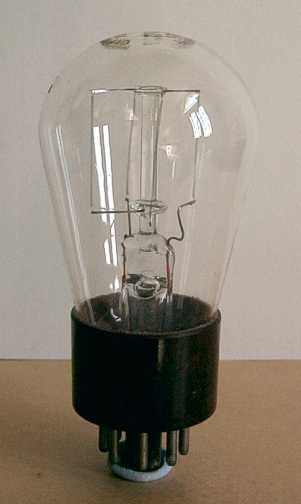 GEC 306 Barretter.
GEC 306 Barretter.
This is a rather unusual device which I originally mistook for an incandescent lamp.
It is actually a type of regulator called a barretter.
The envelope is filled with hydrogen and contains an iron filament. The temperature
co-efficient is chosen to keep the circuit current constant over a wide voltage
range.
This type of device is referred to in the 1948 Ediswan data book as a 'hydrogen
filled resistance lamp'.
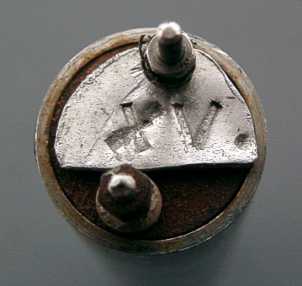 Mystery Object!
Mystery Object!
I found this in a toolbox full of nuts and bolts. The outer housing
is stainless steel. The device seems to be designed to work at
high temperature because all the insulators are ceramic. Inside
the tube there is a ceramic magnet which surrounds a coil. A thin
ferrous rod extends from the coil into the stainless steel tube
at the end of the device.
The only application I can think of is that it may have been used
to detect a moving ferrous object. It may have been part of a
tachometer or flow meter. Do you have any idea what it might be?


 This is a totally bizarre electromechanical indicator device made by
Dowty. It uses four triangular sections which are rotated by a rack
arrangement. The indicator normally displays the red up arrow, but
when either of two electromagnets are energized, the triangles rotate
to display one of the other two legends.
This is a totally bizarre electromechanical indicator device made by
Dowty. It uses four triangular sections which are rotated by a rack
arrangement. The indicator normally displays the red up arrow, but
when either of two electromagnets are energized, the triangles rotate
to display one of the other two legends. This hand crafted box is labelled 'The Cox-Cavendish Electrical Co.
Ltd. X-Ray & Electro-Medical Apparatus'. It appears to contain an
induction coil. I tried connecting it to a dc supply and it started
making a threatening noise rather like a rattle snake. It is almost
certainly a faradic medical battery, used for muscular therapy.
This hand crafted box is labelled 'The Cox-Cavendish Electrical Co.
Ltd. X-Ray & Electro-Medical Apparatus'. It appears to contain an
induction coil. I tried connecting it to a dc supply and it started
making a threatening noise rather like a rattle snake. It is almost
certainly a faradic medical battery, used for muscular therapy.  This is an early digital component which they called a logical
circuit element. This device is a monostable.
This is an early digital component which they called a logical
circuit element. This device is a monostable. This is a 100kHz crystal oscillator module. The crystal is in the
glass tube. It was made by Venner Electronics Limited and contains germanium
transistors. The module is potted in solid plastic. It measures 125mm
high including the pins.
This is a 100kHz crystal oscillator module. The crystal is in the
glass tube. It was made by Venner Electronics Limited and contains germanium
transistors. The module is potted in solid plastic. It measures 125mm
high including the pins. Ediswan DLS10 time delay switch.
Ediswan DLS10 time delay switch. GEC 306 Barretter.
GEC 306 Barretter. Mystery Object!
Mystery Object!
